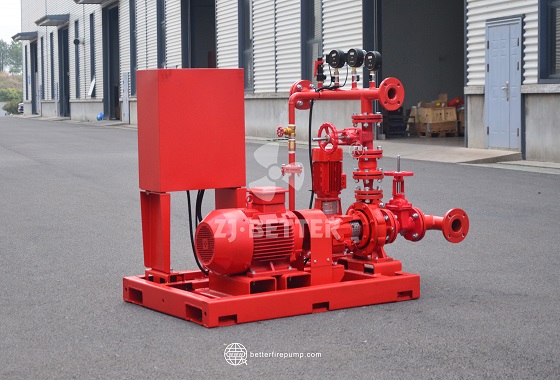In high-density urban environments and modern high-rise buildings, the reliability of fire protection systems directly determines disaster response capabilities. Electric fire pumps provide continuous and stable water pressure support for fire protection water supply systems through intelligent structural design, low-noise operation, automated control, and high-efficiency output, helping building safety systems deliver optimal response performance at critical moments.
1. Intelligent electric control system improves startup speed
Electric fire pumps are equipped with high-performance PLC control cabinets and intelligent startup algorithms, enabling initial judgment upon receiving a signal and triggering soft-start routines to rapidly engage the motor and enter operation—eliminating mechanical delays. This intelligent control not only saves startup time but also adjusts the pump startup strategy based on actual water pressure requirements, avoiding the adverse effects of frequent startups and shutdowns on equipment lifespan. The electric fire pump integrates a high-performance PLC control cabinet and intelligent startup algorithm, enabling immediate initial detection upon receiving a command. It triggers soft-start routines to rapidly engage the motor and rapidly enter operation—eliminating mechanical delays. This intelligent system not only saves startup time but also optimizes pump activation based on actual water pressure demand, avoiding wear caused by frequent cycling.
2. Constant Pressure and Pressure Fluctuation Suppression
High-performance pressure sensors monitor changes in pipeline pressure. Once the pressure drops below the preset threshold, the pump group immediately starts; when the pressure returns to the target range, the system automatically stops or slows down, ensuring stable output pressure without significant fluctuations. This effectively suppresses pressure fluctuations and water hammer effects, providing continuous support for firefighting operations.
3. Soft Start and Speed Control Protection System
Electric fire pumps use vector variable frequency drives or soft start devices to reduce startup impact, prevent grid interference, and minimize mechanical shock. Additionally, the system supports variable frequency speed control, enabling precise flow and pressure regulation by adjusting speed to accommodate diverse operational requirements while extending the lifespan of core components.
4. Compact Structure and Modular Installation
The electric fire pump unit features an integrated base design, integrating the pump body, motor, control cabinet, sensors, and other components onto a single platform with pre-installed piping connections, enabling quick installation and commissioning. On-site personnel can quickly connect using standard mounting brackets, reducing wiring and piping installation time, making engineering deployment more efficient, tidier, and more professional. The electric fire pump unit features an integrated base design housing the pump, motor, control cabinet, and sensors on a single platform with pre-installed piping connections. Workers can quickly install and commission it using standard mounting brackets. This significantly reduces installation time and improves engineering efficiency, resulting in cleaner, more professional setups.
5. Zero emissions during operation, environmentally friendly and low noise
Electric drives have no fuel combustion, avoiding exhaust emissions, making them more suitable for environmentally sensitive or enclosed spaces. Their noise control is superior to diesel pumps, with operating noise below 60 dB (as low as 50 dB), meeting building noise control standards and providing a more comfortable environment for areas such as hospitals and offices. Driven by electricity, electric fire pumps have zero fuel combustion emissions, making them suitable for environmentally sensitive or enclosed spaces. Their noise levels are significantly lower than diesel units—typically under 60 dB, and as low as 50 dB. This meets building noise standards and ensures a more comfortable environment in hospitals and offices.
6. Power recovery capability and emergency support during power outages
Equipped with dual-circuit power switching functionality, it can connect to mains power and backup power sources (UPS, generator sets, etc.), ensuring rapid system switching and startup after a main power outage to maintain uninterrupted water pressure supply. This redundant design provides disaster-ready backup assurance, ensuring continuous system response during critical moments.
7. Maintenance-Friendly and Cost-Effective
The motor and control system do not require fuel or exhaust systems. Routine maintenance only involves electrical inspections, bearing lubrication, control cabinet monitoring, and software updates, eliminating the need for fuel consumption or filter replacements. Annual maintenance costs can be reduced by 30–40%, while system reliability is significantly enhanced.
8. Precise monitoring and data recording capabilities
The system provides real-time monitoring of parameters such as pressure, current, voltage, temperature, and runtime, and can store historical data, supporting USB export or remote cloud platform access. It features fault alarm functions for anomalies such as abnormal temperature, overload, or low-voltage phase loss, triggering alarms and remote notifications to reduce fault response times. The system provides real-time monitoring of parameters like pressure, current, voltage, temperature, and runtime, with storage of historical data. It supports USB export and remote cloud access. Equipped with fault alarms for anomalies such as overtemperature, overload, and low voltage, it enables quick remote notifications, significantly reducing response times.
9. Multi-Pump Combination and Interlocking Capability
To meet the water supply needs of large-scale or zoned high-rise buildings, the system supports parallel connection of multiple motor pump sets, enabling staged start/stop and alternating rotation through software configuration. Multiple pump sets working in tandem enhance system reliability and output capacity while ensuring more balanced component lifespan distribution over long-term use.
10. Standard Certification and Customization Capability
The product complies with the national standard GB6245 and supports NFPA, UL/FM pipe interface materials, corrosion resistance, etc., and is suitable for use in special environments (such as marine, chemical plants, and low-temperature zones).
The electric fire pump overcomes the limitations of traditional fuel-powered pumps through its intelligent control system, efficient drive structure, environmentally friendly operation, and modular design, providing stable, continuous, high-pressure water supply support whether in normal water supply conditions or during fire emergencies. It is not only the preferred fire pump system for high-rise buildings, commercial complexes, hospitals, campuses, and other facilities but also represents the modern fire protection system's higher pursuit of intelligence, energy efficiency, and safety.
